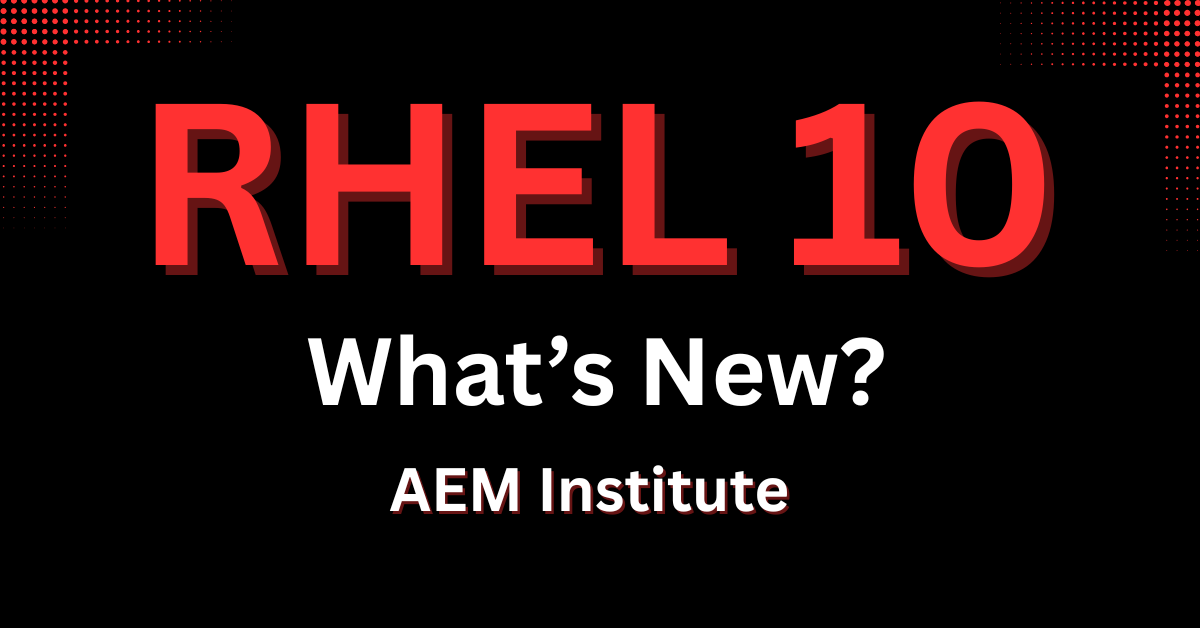RHEL 10 Release – All the New Features and Changes You Need to Know in 2025
Red Hat Enterprise Linux (RHEL) 10 has officially launched, bringing with it a powerful collection of improvements aimed at enterprise, cloud, and hybrid deployments. Unlike a small step forward, this release represents a significant leap in performance, security, automation, and cloud readiness.
Whether you’re a systems administrator, IT decision‑maker, DevOps engineer, or developer, getting up to speed on what’s new in RHEL 10 is essential to fully leverage its potential. This guide breaks down every major update, helping you understand why many organizations are already planning upgrades.
Quick Overview – Why RHEL 10 Matters
Released in 2025, Red Hat Enterprise Linux 10 is designed with the modern, distributed IT environment in mind. It introduces smarter system management powered by AI, greatly improved container deployment options, next‑generation security to defend against emerging threats, and better performance on the latest hardware platforms.
Compatible with key architectures—x86‑64, ARM64, IBM Z, and Power—RHEL 10 is positioned to be the operating system of choice for enterprise workloads across bare metal, virtual infrastructure, public cloud, and edge computing.
Highlights of RHEL 10’s New Capabilities
1. Lightspeed – AI‑Driven System Management
One of the headline additions in RHEL 10 is Lightspeed, an integrated AI-powered assistant for Linux administration. This innovation allows you to interact with your systems using natural language commands or questions.
What makes Lightspeed special:
- Understands plain‑English commands for troubleshooting and configuration.
- Provides tailored solutions by drawing from Red Hat’s own knowledge base.
- Suggests performance and security optimizations based on real‑time system context.
This feature is a game‑changer for teams managing large-scale or complex environments, reducing the skill barrier for Linux management.
2. Image Mode – Deploy Linux Like a Container
RHEL 10 introduces image mode, allowing you to roll out the operating system itself as an immutable, bootable container image.
Key benefits include:
- Consistent deployments across data centers, cloud providers, and edge devices.
- Faster patching and upgrades with minimal risk of configuration drift.
- Simplified management when running both applications and the OS as images.
For organizations already deep into container-native workflows, image mode creates a natural bridge between infrastructure and application delivery.
3. Edge and Hybrid Cloud Readiness
RHEL 10 is deeply optimized for multi-cloud and hybrid deployments, offering expanded integrations and management tools:
- Tighter OpenShift integration for Kubernetes and containerized applications.
- Full compatibility with AWS, Azure, Google Cloud, and other major providers.
- Optimized for edge – reduced footprint, remote update capabilities, and resilience in low-connectivity environments.
For enterprises looking to maintain flexible IT infrastructure, these capabilities offer both scalability and reliability.
Security – Built for the Post‑Quantum Future
Security is a defining aspect of RHEL 10. It includes measures that prepare organizations for the evolving landscape of threats, including those posed by quantum computing.
Security advancements include:
- Post‑Quantum Cryptography support with FIPS compliance, reducing the risk of long-term encrypted data exposure.
- Native TLS 1.3 for all system communications, ensuring high-grade encryption.
- Stronger SELinux enforcement with improved usability for compliance.
- Built‑in DNS-over-HTTPS (DoH) to protect DNS queries from interception.
Combined with AI-driven security recommendations, RHEL 10 ensures your infrastructure is protected and compliant from day one.
Performance & Hardware Enhancements
Under the hood, RHEL 10 takes advantage of Linux Kernel 6.12.0, which offers significant performance and scalability improvements.
Highlight improvements:
- Better workload scheduling and memory management for high‑demand applications.
- Broader hardware compatibility, covering the latest CPUs, GPUs, storage solutions, and networking technologies.
- More precise resource allocation for containerized workloads, improving efficiency in dense deployment environments.
These optimizations make RHEL 10 an excellent choice for both traditional server applications and resource-sensitive edge deployments.
Developer-Focused Updates
Developers will appreciate the modernized toolsets included in RHEL 10.
- Latest languages and frameworks: Python 3.12, PHP 8.3, Node.js, Java, Go, and more.
- Updated application streams allowing independent updates of packages without waiting for OS releases.
- Enhanced container tools such as Podman, Buildah, and Skopeo for streamlined app development.
- WSL (Windows Subsystem for Linux) support for running RHEL development environments seamlessly on Windows desktops.
By giving developers the newest versions of tools, RHEL 10 shortens the time to market for new applications.
Better Automation and Management
System administration in RHEL 10 is not only smarter but also more automated.
- AI‑assisted CLI workflows powered by Lightspeed reduce time spent on repetitive tasks.
- Predefined system roles for performance tuning, compliance configuration, and application hosting.
- Improved web console offering an intuitive interface for managing physical, virtual, and cloud instances.
This automation focus helps IT teams maintain efficiency and reduce operational risk.
RHEL 10 vs. Previous Versions – A Snapshot
| Feature | RHEL 8/9 | RHEL 10 |
|---|---|---|
| Kernel Version | 4.x–5.x series | 6.12.0 with major scalability upgrades |
| AI Integration | None | Lightspeed for AI-based management |
| Deployment Flexibility | Traditional OS installs only | Full image-based OS deployment |
| Security | FIPS (traditional), SELinux | Post‑Quantum FIPS, encrypted DNS, TLS 1.3 |
| Developer Tooling | Older defaults | Latest language/runtime support |
| Cloud/Edge Integration | Limited enhancements | Deep hybrid cloud & edge optimization |
Common Questions About RHEL 10
1. Is RHEL 10 worth upgrading to from RHEL 9?
Yes—especially if you value AI-based management, container-centric deployment, post-quantum security, and better cloud-native performance.
2. Does RHEL 10 still work in traditional data centers?
Absolutely. While optimized for modern environments, it continues to deliver stability and compatibility for on-premise workloads.
3. Are there any licensing changes?
Pricing and subscription models are consistent with Red Hat’s enterprise offerings, but always verify with a provider before upgrading.
Final Thoughts
RHEL 10 is more than an operating system—it’s a future‑ready enterprise platform. From AI-powered administration and post‑quantum security to image‑based deployments and developer‑friendly tooling, Red Hat has positioned this release to meet the growing demands of modern IT environments.
If your organization relies on stability, security, and flexibility, moving to RHEL 10 could be one of the most strategic technology decisions you make this year.

Pro Tip: Upgrading early lets your team adapt to new features at your own pace, while positioning your infrastructure to handle future workloads without disruption.

Cybersecurity Architect | Cloud-Native Defense | AI/ML Security | DevSecOps
With over 23 years of experience in cybersecurity, I specialize in building resilient, zero-trust digital ecosystems across multi-cloud (AWS, Azure, GCP) and Kubernetes (EKS, AKS, GKE) environments. My journey began in network security—firewalls, IDS/IPS—and expanded into Linux/Windows hardening, IAM, and DevSecOps automation using Terraform, GitLab CI/CD, and policy-as-code tools like OPA and Checkov.
Today, my focus is on securing AI/ML adoption through MLSecOps, protecting models from adversarial attacks with tools like Robust Intelligence and Microsoft Counterfit. I integrate AISecOps for threat detection (Darktrace, Microsoft Security Copilot) and automate incident response with forensics-driven workflows (Elastic SIEM, TheHive).
Whether it’s hardening cloud-native stacks, embedding security into CI/CD pipelines, or safeguarding AI systems, I bridge the gap between security and innovation—ensuring defense scales with speed.
Let’s connect and discuss the future of secure, intelligent infrastructure.
